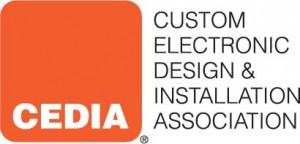 As long time readers of strata-GEE.com (and the previous stratecongroup.com) know, for the last three years, we have conducted a survey of our readers on their attitudes of both the Consumer Electronics Show (CES) and the CEDIA EXPO. Last month, our CEDIA EXPO survey saw a dramatic increase in participation – up over 90%.
As long time readers of strata-GEE.com (and the previous stratecongroup.com) know, for the last three years, we have conducted a survey of our readers on their attitudes of both the Consumer Electronics Show (CES) and the CEDIA EXPO. Last month, our CEDIA EXPO survey saw a dramatic increase in participation – up over 90%.
Over 80% of the participants completed the entire survey and a review of the survey results showed that we got a lot of great comments on our open-ended questions. Whether positive or negative, it was clear that strata-GEE.com readers were serious, thoughtful, engaged, and concerned about this event.
Now, in a first for us, CEDIA responds to our survey – and more – in an exclusive interview…
At EXPO, we approached Buzz Delano, a member of the Board of Directors for CEDIA, and requested an interview with him sometime after the show to discuss some of the feedback from our survey, as well as to get the organization’s viewpoint on other topics as well. Not only did Delano agree to this interview, but to our surprise, so too did Jamie (Antcliff) Riley (CEDIA Senior Director of PR & Marketing), and Federico Bausone (Chairman of the Board), who were all interested in making a sincere outreach to members of the media like strata-GEE.com.
This interview took place last week and we were struck by the openness and transparency of the CEDIA executives in answering our questions. It was clear to us that CEDIA is serious about increasing the visibility of the association’s management and did not duck any of our questions…even the hardballs we threw in their direction. In a telephone conference call that lasted almost a full hour, the CEDIA executives only refused to answer one question, and this was under the advice of their attorney – but more on that later.
If you haven’t seen our CEDIA Expo Survey Results, you may want to consult them here before reading further…
Hot topics…
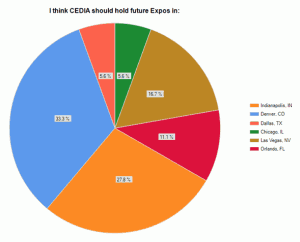
(Click to enlarge)
Our first question to the CEDIA team centered on the issue of the location of the show. As I’m sure many of you remember, ever since it first started in 1989 – the show has circulated to several cities around the country. However, a couple of years ago, the show moved from Denver to Atlanta – a move that turned out to be controversial and was widely panned by many of the CEDIA members attending the Expo.
This negative response was reflected in our EXPO survey as well when we asked respondents to write in a response to this open-ended question: “CEDIA EXPO could be even more important to me and my business if they would:…” Answers included: “Move it back to Denver…”; “Move to Chicago…”; “Bring it to Orlando…”; “When it goes back to Denver…”
In our 2011 version of the survey – conducted after the first year in Atlanta but before the second one – we even gave a list of cities for respondents to vote on. The winner was Denver, followed closely by Indianapolis. Not surprisingly, no one voted for Atlanta (or Los Angeles for that matter).
How is the market for the location for Expo chosen?…
So, we asked, how is the location for the annual Expo chosen? When first launched in 1989, the idea was to periodically move the show to various cities around the country roughly every three years, Delano told us. This made sense when the organization was small – but as it grew, this became more of a challenge as some cities did not have facilities large enough for the event. A key consideration for which market in which to locate Expo is flight access, whether it has easy access for flights from most parts of the country. Not all cities offer this, Delano noted.
For various reasons, CEDIA now plans to move the show every two years, which according to Delano “make(s) more sense” and gives them more flexibility. And, they told us, they are pleased to announce that next year the CEDIA Expo will move back to Denver for two years. After that, Expo will move to Dallas for two years.
Show planning begins with market planning…
Riley added that show location planning starts at least three-to-five years in advance. Factors that the selection committee must consider when looking at markets include: 1) Whether cities have adequate facilities for a show this large; 2) The local weather at that time of year – which is why they won’t do Orlando in September since that time frame is during hurricane season there; And 3) The cost to exhibitors. Riley said that in some locations – like Chicago – the cost would become “astronomical for exhibitors” for any type of services that convention center would offer exhibitors.
“And then the other thing that’s happened…we thought Atlanta was going to be beautiful because it had those characteristics where you had a direct flight from everywhere,” Bausone added. “And we thought it was going to be fantastic…and it just wasn’t. Our members said it was horrible, get it out of here now, quickly.”
Showing remarkable responsiveness to its members’ opinion – CEDIA immediately made an effort to change the location – hence, the move back to Denver. “It was hard,” Bausone told me, “but we made the change immediately.” Denver, they said, was an easy choice since it had been a popular location with most members.
But what about that nagging and continual attendance decline?…

Buzz Delano, CEDIA Director
Was the selection of Indianapolis – which we also heard complaints about – in their opinion, a contributing factor for the decline in attendance? Quickly and firmly, the executives said that they didn’t feel this was the case.
Delano noted that trade shows have new headwinds for reasons previously identified by strata-GEE.com and others. In the past, the trade show was the only place dealers could get reliable information about trends in technology, trends in products, and the new lines from their vendors. Now, thanks to the Internet – much of this information is easily available – right from your desktop.
No, Delano said plainly: “I think the biggest contributing factor to where we are at attendance level, overall and from specific member groups, it really is the economy. It really is things that are going on out there in the world that has made a lot of things scale down and change.”
Delano went on to agree that, “While you can’t replace what you get in person at anybody’s trade show, the fact is things have become a little bit diluted” as far as so much information now readily available outside of the trade show environment.
“I think the general attendance was lower because manufacturers just got more efficient,” Bausone interjected. “Instead of taking so many people, they…first of all they had smaller booths, but a booth…and didn’t take everyone. They just were more efficient at it. So that’s where we saw a big decline in percentage. With the exception of planet Crestron, I mean, the booths weren’t that big.”
And, Delano added, this tightening was probably in the exhibitors’ budgets…no matter where the show was held.
But what about dealer attendance?…
Another complaint raised by some of the respondents to our EXPO survey was the more specific issue of declining attendance among dealers…the primary reason that many exhibitors pay so much money to display at the show. CEDIA refers to a dealer as an Electronic Systems Contractor or ESC. At this most recent EXPO, ESC attendance “was actually up by 4½% over last year” Jamie Riley told us. This was the first year that the ESC category was up by that much, she added.
When I asked for this breakdown – in either numbers or in percentages – from EXPO’s in past years, I was told that they did not have this historical information as attendance was not tracked that way. However, Delano said that there are plans to update their reservation system in the future which may make this detail available. Of course, I was a little disappointed as it is hard to track the meaning of a 4½% ESC attendance increase claim without being able to put it in historical context.
Still, taken at face value, even though the overall attendance figures had declined again for last month’s show, the fact that ESC attendance was up would be considered a positive to EXPO exhibitors. And, I might add, a pleasant surprise given the continual consolidation of the channel.
Lack of first time attendees…
Another issue we raised with the group was a result from our survey that I found troubling – even though almost 80% of those taking the survey said they were planning to attend EXPO, not a single respondent identified themselves as a first time attendee. As this could be an indicator of the health and vibrancy of the show, we asked the CEDIA executives about this result.
“I do know that year-over-year we usually trend about 15-20% in new first time attendees,” Riley said. “And that’s inclusive of all registrants types…it’s not broken out as to the core type. I will speak to the fact that this year – you know one of the plan initiatives that our board has ratified obviously is to build a workforce – and we’ve had a huge growth in the amount of students – that amounts to your future dealers and future buyers that have attended the show. This year we had a 40% increase in the amount of students – so that’s a key indicator of what’s to come, I believe.”
The students of EXPO…
This year, first time attendees – as Riley identified as is usual – was up that 15% figure. Keep in mind that this statistic includes the students who Riley identifies as Vo-Tech or high school students who are taking a curriculum consistent to funnel them into the channel of residential home technology. “So we have a concerted effort to grow the pipeline of workforce.”
CEDIA participates and supports ESPA – Electronic Systems Professional Alliance which it feels is a strategically important effort to grow the future workforce. The increasing student attendance is something that CEDIA is excited and proud about…we’re not sure about its significance.
“CEDIA EXPO not meaningful to my business anymore…”
We then told the CEDIA executives that one surprising response from our EXPO survey was the 50% of those who said they were not attending was due to the fact that “CEDIA EXPO is not meaningful for my business anymore…” We asked them if they had an opinion of why our respondents felt that way.
“Well I think it’s because you can get most of the information on the Internet, so I think that’s one of the reasons why they’d say ‘CEDIA EXPO doesn’t do that much for my business,'” Bausone said. “And they’re really missing the point. It’s not just about the information, it’s also about who you meet…and when they do go – they love it. And I think that’s why they would say it’s not necessary, because if I wanted a brochure – there are no brochures. It used to be that brochures were given out and now its pdfs and virtual information all over. So you can get that anywhere.”
If that’s the case then, how do you fight that? “We played with the phrase, ‘If you don’t go, you won’t know,” Bausone added.
If you don’t go, you won’t know…
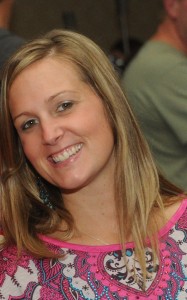
Jamie (Antcliff) Riley, Senior Director of PR & Marketing
Delano and Riley added that one of the ways they add value to the show is by creating multiple opportunities for networking – something that is often pointed to as a valuable benefit of attending a show. Also, they continually revamp the educational component to make it more meaningful.
This year, the group focused on the growing influence of IP-enabled networks…even creating a special certification.
“They HAVE to know the network,” Riley asserted. “At EXPO, we launched our brand new residential networking credential. It’s the first of its kind – there’s no other credential out there that designates an ESC-type business with this credential that’s going to put them in the home of the homeowner – and not necessarily the IT-guy. They’re going to be all-inclusive, so they’re going to be able to maintain all things that are enabled over the Internet. And that’s kind of where we’re going with the Future Tech Pavilion, introducing new unique credentials, as well as curriculum that you really can’t get that online or you’ve got to have that face-to-face – that conversation – to really understand it. So that’s where the big focus is of our board, our education team, as well as our emerging technology team.”
The change in operating style of CEDIA…
At this point, we moved away from the survey and on to other topics that strata-GEE.com readers have asked us about. The organization, we said, appeared to be undergoing a transformation. In the recent past, there was a CEO (Utz Baldwin), a corporate staff, and a methodical or professional approach to running the organization. Now, the CEO is gone and the group appears to be moving back to more of a volunteer organization. So we asked the executives, why the change?
“Let me just start with the fact that we are a volunteer association,” Bausone proclaimed. “I was reading some of the [strata-GEE.com’s CEDIA EXPO] survey’s comments on your last question about ‘They’re not listening anymore…they’re not listening to us members, they’re not listening…,'” Bausone continued. “And we set out to say,’Yes we do listen, and we do appreciate, and we do want hour help,’ and all of the courses. Not that professional staff isn’t professional…it’s just as professional…but even the volunteer structure which we had changed, because we thought that was best…we just changed it back, because we do need that volunteerism.”
A little too rigid…
Delano added that the association – in the past – had created a new structure that was even more professional and more corporate…but that after a couple of years it began to appear “perhaps a little too rigid in some ways.” The board began to hear feedback of this nature in various forums, survey’s, member discussions, that supported this view.
Some of this feedback began to cause some concern and the decision was made to swing the association back to its roots in volunteerism.
“And we’re now at a point where we think it’s a much better blend of the very professional staff we have and a cohesive strategic plan,” Delano said. “But we are centered far more on making sure the volunteer leadership is really top, and is really leading the way. And that was a decision we made last year, and I think we’re getting close to – coming up on a year – beginning to have some real vibe for that taking effect and I think you’ve noticed it.”
Jumping in, Bausone added: “The idea is to have much more of a balanced approach – not just whatever the volunteer says or whatever staff says – but it’s a partnership…a balanced approach. We might have been all left and then all right and now we’re trying to be more of a balanced approach.”
“Yes,” Delano declared. “You know it’s an election year, so we’re being bipartisan!”
The “Utz” question…
Ever since CEDIA’s first – and perhaps only CEO – Utz Baldwin left the organization in early December 2011, strata-GEE.com readers (and some CEDIA members) have been curious as to what led up to the exodus of this somewhat popular, somewhat controversial figure. But the organization has remained steadfastly mute on the topic. strata-GEE.com has spoken with several association figures – both staff and volunteer – and have not been successful in getting anyone to speak for the record.
So we asked these executives, in the spirit of transparency, just why was Baldwin forced out of the organization? Delano spoke first – denying that Baldwin was forced out.
“It’s an employment issue, first and foremost, so we really can’t comment on it,” Delano said firmly. “But he wasn’t forced out.”
We prevailed, if it was a legitimate business decision – i.e. a change in direction, or whatever – why not just come out and say that?
“We were instructed, ‘Don’t talk about this,’ by the association’s lawyer,” Bausone said, clearing the air on the matter. With that, we moved on…
Bausone’s board tenure…
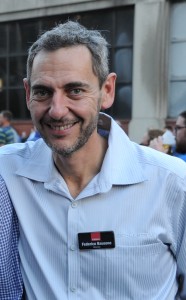
Federico Bausone, Chairman of the Board
We turned to Bausone’s term as Chairman of the Board…asking him to describe his priority issues during his tenure on the Board.
“We have four main initiatives,” Bausone began. “One is to be able to influence the market. The other one is we have education – or building a skilled workforce. We also want to promote commerce – and everything we’ve been doing is aligned towards these things. I mean have you been to our portal lately? That’s promoting commerce completely. And the other is, we have to be the voice of authority – I mean if you want to know – go to CEDIA and learn what your industry is about. So those are our four key directives at the Board.”
CEDIA is in the middle of their board elections right now, which end October 22nd. “If I don’t get fired,” Bausone joked, “I’ll be serving another year.”
Mentioning members…
We asked the executives about the status of the CEDIA membership.
“If we’re talking global, then we have around 3,000 total from all of our offices,” Riley told me. And membership, the executives assured me, did grow last year.
They didn’t have the U.S. membership number but promised to forward them to me in the near future. But Bausone was quick to mention a fundamental for the association.
“And under these key initiatives is – how do we bring more value to the members and, therefore, have more members,” Bausone said. “If I’m in this industry and somehow CEDIA can bring me more jobs, then that is like the Holy Grail. And that is exactly what we set out to do.”
This was the most open, wide-ranging, and honest discussion we’ve ever had with CEDIA. We were free to ask any question…and we felt free to push harder on any question that we felt needed a more complete answer. The executives either answered our question, or if they didn’t, they explained the reasons behind why they declined to answer.
But it was clear that CEDIA wanted to address the concerns and/or comments of strata-GEE.com readers as completely as possible. And that, in-and-of-itself. is a refreshing first for us.



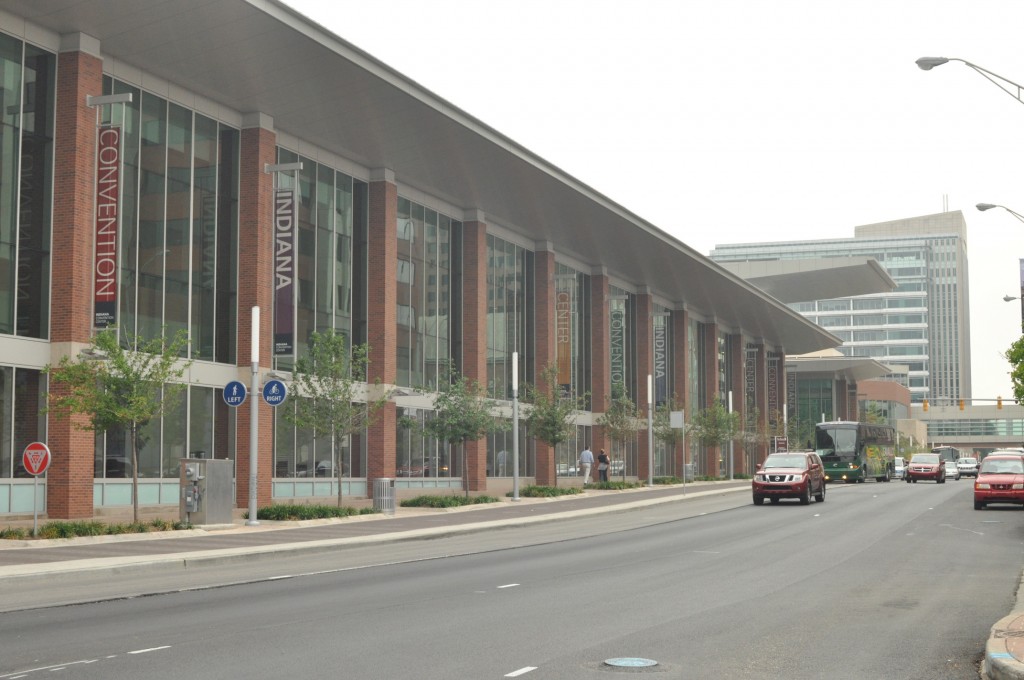


Leave a Reply